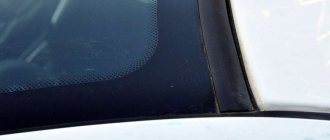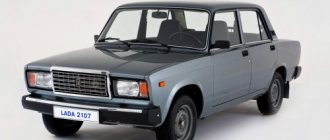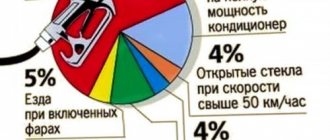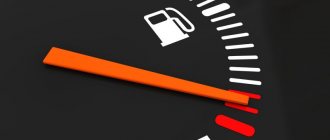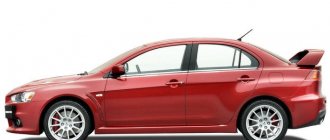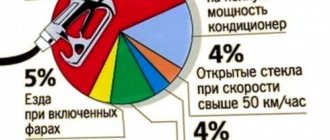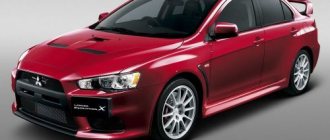There are four main models of the Lada Kalina passenger car:
- sedan - has a closed body, with 2-3 rows of seats for the driver and passengers, the trunk is separated from the car interior, there is no lifting door in the rear wall;
- station wagon - has a closed cargo-passenger body, one of the sedan variants, which has an enlarged luggage compartment, is equipped with a lifting door in the rear wall;
- hatchback - has a body with 1-2 rows of driver and passenger seats, with a shortened rear overhang (hence the name - “hatchback” means “short”) and a smaller luggage compartment, equipped with a lift-up door in the rear wall;
- sport - is a sports version, which is equipped with a number of special parts - a bumper, an exhaust pipe tip, sports pedals, alloy wheels, a SAAZ Sport sports suspension, front and rear disc brakes, an original reinforced gearbox.
As you can see, the main difference between each model is its body type. Gasoline consumption (unleaded AI-95) is calculated in liters over a driving cycle, which is 100 kilometers.
In this case, the following parameters of the vehicle itself are taken into account:
- Engine size (Lada Kalina comes in two types - 1.4 l and 1.6 l).
- Number of valves (for Lada Kalina - 8 and 16).
Experts have prepared an information table that shows the factory fuel consumption indicators for each model of the Lada Kalina passenger car, taking into account the mandatory parameters.
Model Lada Kalina
1.6 l (8 valves)
The manufacturer sets the standards for digital fuel consumption indicators for each Lada Kalina model based on the results of test runs of passenger cars on a special track. But on the track, driving conditions are reduced to ideal, and the car is driven by an experienced driver. In real conditions, everything becomes much more complicated. In addition, the speed indicator during real driving is not always within the required limits - from 100 km/h to 120 km/h. This is due to the fact that some drivers do not recognize the established framework for optimal driving of a Lada Kalina car, which significantly affects fuel costs.
Lada Kalina 2004 - 2013
First cars
The first production sedan was equipped with a 1.6-liter eight-valve engine. The production of this engine was well tested and familiar. It almost completely, with minor improvements, repeated the design of the power unit of the VAZ G8, but only its volume increased. Power 82 hp enough to complete the assigned tasks - driving in city traffic and driving on the highway at the speed allowed in Russia.
New bodies and engines
Since 2006, cars with a hatchback body began to roll off the assembly line, and in 2007 a station wagon appeared. The evolution of power units was continued by a motor with the same volume, but with a 16-valve mechanism. The car's power has increased, and so has its acceleration dynamics. Unfortunately, the fuel consumption of the Lada Kalina often exceeded the figures stated by the manufacturer. They tried to reduce it by reducing the engine volume from 1.6 to 1.4 liters. Power dropped by 20 hp. s., but the new engine actually consumed less gasoline.
Gearbox and features of the first generation
All Kalinas until 2013 were equipped with a 5-speed manual transmission. The fuel injection and ignition processes are controlled electronically. During its release, the model acquired an anti-lock brake system, electric power steering and air conditioning, which was installed on upgraded cars.
Fuel consumption depending on engine
- The 8-valve engine with 1600 cc capacity is characterized by low power but excellent torque. When the load increases, there is often no need to downshift. The advantage is that damage to the timing belt will not cause the valves to collide with the pistons, and they will not be deformed. The downside is that it is noisy during operation. When driving on the highway at a speed of 90 km/h, the claimed consumption is 5.5 liters per 100 km.
- The 1.6-liter power unit, equipped with sixteen valves, is significantly more powerful than its predecessor, but its thrust has decreased. It is more capricious in terms of fuel and oil, its maintenance and repairs are more expensive. True, it also consumes less gasoline: according to the manufacturer, consumption on the highway is about 5 liters, in the city - 7 liters, mixed - 6 liters. The actual figures are slightly higher. The main reason for greater efficiency with increased power is better efficiency when consuming the fuel-air mixture, faster fuel supply to the cylinder and exhaust gas output.
- The most economical is the smaller engine with 16 valves. The revolutions have increased to 4.5 thousand per minute, but driving with a load in high gear is unlikely to be possible. If the timing belt breaks, there is a risk of bending the valves, and this will affect the cost of repairs.
| Modification | 1.6, 8 grades, 5 grades. Manual transmission | 1.6, 16 grades, 5 grades Manual transmission | 1.4, 16 grades, 5 grades Manual transmission |
| Consumption city, l/100 km | 7,7 | 9,8 | 8,5 |
| Route, l/100 km | 5,5 | 6 | 5,5 |
| Combined cycle consumption, l/100 km | 7,5 | 7,2 | 7,5 |
| Acceleration, sec up to 100 km/h | 13,5 | 12 | 12,5 |
Real fuel consumption of Lada Kalina (according to reviews from car owners)
Many car owners of the Lada Kalina passenger car complain that in reality, gasoline consumption indicators differ from those specified by the manufacturer. For comparison, let’s look at another information table prepared by specialists taking into account feedback from Lada Kalina car owners.
| Terrain type | Lada Kalina, 1.4 l | Lada Kalina, 1.6 l | ||
| Fuel consumption (l/100 km) | Average (l/100 km) | Fuel consumption (l/100 km) | Average (l/100 km) | |
| Urban | 6,8-11,5 | 8,47 | 7,0-12 | 9,5 |
| Route | 5,0-8,5 | 6,18 | 5,6-9 | 6,8 |
| Mixed | 6,5-8,3 | 7,29 | 7,0-9,0 | 8,0 |
When comparing two information tables, it is clear that the real figures are indeed higher than the stated factory fuel consumption standards for the Lada Kalina. What are the reasons for this discrepancy between the figures?
The main reasons for the difference between the gas consumption figures for the Lada Kalina passenger car - real and factory ones
There are several reasons for the discrepancy between the actual gasoline consumption figures of the Lada Kalina and the factory standards. Experienced car enthusiasts identify typical ones among them:
- Type of terrain - driving in the city, on the highway, off-road or mixed type of road (the more complex the type of road, the higher the fuel consumption).
- The driver's driving style is slow driving, fast driving, with sharp acceleration, with sharp braking (the more complex the driving style, the higher the gas consumption).
- The quality of the fuel used - AI-95 gasoline is consumed less than AI-92 gasoline.
- Time of year - in winter, fuel consumption rates will be higher, this is affected by icing of the road surface and frequent warming up of the vehicle itself.
- Traffic jams - due to slow driving and frequent braking, gasoline consumption increases by almost several liters.
- Using additional car devices (for example, air conditioning) – with devices constantly on, gasoline consumption will be 0.5-1 liter more.
In addition to the reasons listed, fuel consumption can be affected by various breakdowns of the vehicle itself:
- incorrect readings of the electronic engine control system due to sensor errors - temperature, mass air flow, oxygen, throttle position;
- abnormal pressure in the fuel system;
- internal combustion engine injector malfunction;
- failure of the catalyst;
- dirty air filter.
To install them, the car owner needs to diagnose the Lada Kalina passenger car. After diagnosing and identifying the causes of malfunctions, the vehicle is repaired.
Technical condition of the car
During break-in, Kalina's engine heats up a little more than usual. This is due to increased friction between parts of the car. As a result, fuel consumption increases. Driving a car with insufficient oil level or poor quality will lead to the same result. The latter is especially worth considering due to the fact that Kalina is equipped with a line of modern engines that are very critical to lubricants.
It is extremely rare for a new car to be faulty. Another thing is the firmware of the control unit. The factory setting has settings intended for engine running-in and subsequent operation under average conditions. According to some owners, this is the cause of gluttony. In this regard, especially desperate car enthusiasts “upload” new ECU firmware. After this, according to them, consumption decreases.
The cause of gluttony may be a faulty catalyst, which is equipped in the exhaust system of all Kalinas without exception. As a result of the formation of soot in it, the filling of the cylinders with air deteriorates, which leads to incomplete combustion of the fuel mixture.
The engine loses its inherent dynamics, and the on-board computer shows higher fuel consumption. The same thing happens if there is a malfunction of the mass air flow sensor. In this case, errors occur in the electronic engine control system. To avoid this, you need to change the air filter more often.
Standard consumption
According to the passport, Kalina in a mixed cycle in the city consumes:
- 7 liters of gasoline per 100 km with a 1.4 liter .
- 7.2-7.8 liters for 1.6 liter .
Real data
- Engines with a volume of 1.4 liters consume about 8.4 liters of fuel in the city. On the highway, consumption is 6.2 liters. In the mixed cycle - about 7.3 liters . These figures were obtained using AI-95 gasoline.
- 1.6 liter engines consume a little more. In the city - 9 liters , and on the highway - 6.8 liters . Accordingly, in a mixed cycle the consumption is about 8 liters .
Winter period
Winter fuel consumption increases significantly during snowfall - the flow speed decreases and, as a result, you have to drive in lower gears.
In winter, the indicator depends on the warm-up time. There is also an empirical dependence on air temperature. The colder it is outside, the more difficult it is for the engine to work (the mechanisms and belts are “oak”).
Our consumption is no less than 10 liters per 100 km . This is on a 16- valve engine with a power of 98 hp .
Thus, the factory figures are slightly underestimated. But in general, Kalina can be considered an economical car.
High fuel consumption on Kalina
Consumption of 13-15 for 8kl is far from the norm.
My consumption in the city was 14-15 liters, it was infuriating and annoying to feel as if you were driving a shnivy.
I measured the mass air flow sensor and there were deviations from the norm. 1.04 I think. Replaced, cleaned the Throttle, IAC, replaced the fuel filter, the spark plugs were fine with a mileage of 3-4 thousand.
And that’s it, a miracle happened - the consumption was 8.5-9 liters. I pour 95 gasoline on Luk-le. The firmware is factory installed, no need to flash anything. Check and replace consumables.
Before sewing a car, a normal diagnostician does diagnostics (included in the cost of sewing), you never know.
Here in Kazan they give a two-week guarantee; if you don’t like it, you can come and update the firmware that was installed and the money will be returned in full.
I stitched it for 1,500 rubles. I advise you to download the firmware from “Icebreaker” or “Paulus”. I filled it with the last one and didn’t regret it a bit. The consumption is less and the dynamics are higher.
Check the mass air flow sensor during diagnostics, it will be immediately obvious.
And in cold weather, the normal consumption for this engine is 12.5-13 liters with warm-ups (maybe you just warmed it up a lot).
In general, if you want to reduce consumption, then install a 4-2-1 pack, then forward flow on 51 pipes, a FOX resonator, a can too (it could be a little more expensive from a Honda), a larger throttle, a zero filter in a standard housing and do online firmware. I think that the consumption will be reduced by 1.5-2 liters (in general, the Kalinovsky engine is very strangled).
I began to notice that fuel consumption has increased significantly, at speed 5 I used to go from 6.8 to 8.5, but now the pedal goes beyond 10k, I try not to press, but even then the speed drops, the average speed is 100 km per hour on the highway, if I press the pedal a little on the on-board vehicle, the consumption shows 9.6 and higher.
Everything works stably, I don’t count the warm-up period, I reset the average consumption before the trip.
I use 95 whenever possible, but at the moment it’s 92, I didn’t notice much of a difference in consumption, I refuel at one gas station.
The fuel filter was also changed in September and the pump screen was changed. I changed the spark plugs in May 13 NGK. Engine 1.6 8kl.
On the highway I have from 5.5 to 7 liters. And in the city it’s from 8.5 to 13 liters, or even more.
Moreover, if you start driving on a not warmed up engine, the average consumption is higher. The experiment lasted two weeks, for a week I warmed up the engine to about 60 degrees and drove, and then a week after starting it, I waited 30 seconds and drove. Mileage approximately 150 km. it turned out, and the consumption when warmed up was 9 liters. On cold 11.5l.
So even such a trifle depends on how much!
No, what do you want? The engine is strangled by the catalyst.
When I bought my swallow, I was simply stunned by its appetite; on the highway I didn’t eat less than 7.5 liters, and in the city, even in the summer, about 10 liters, and in the winter I got up to 12.
I went to the services and asked me to do something, but everyone waved me off and said to calm down.
Then, when I tuned the engine a little, the consumption remained the same and the horses increased (and this is on large valves, on a 52 camshaft and Volga injectors).
I think that if you install a spider 4-2-1 shaft, leave the original one and do online firmware, then the consumption can be reduced...
Only registered and authorized users can leave comments.
Source
Financial life
Daewoo Matiz SMALLCAR (STEPWAY) › Logbook › FUEL CONSUMPTION.
HELP immediately (Lada Kalina 1.6 8 valve.) Hello everyone, well, I decided to ask you to advise me on the car of my beloved girl. We have a Lada Kalina 2007 with a 1.6 engine (8-valve) with a mileage of 95 thousand km, since the summer the on-board computer built into the device panel began to frighten the fuel consumption: it was at least 9.8-10.2 liters, on my own I replaced the spark plugs, oil, all filters and thereby achieved a consumption of 9.6-10 liters in the city, which by and large does not make me happy ((maybe I’m not asking for the real thing?) But after reading the forums and the operating manual Lada Kalina with such an engine in the city must consume 7.8-8.5 liters. On the highway, the consumption is approximately 6-7 liters if you do not drive more than 110 km. And the Kalina also has the usual knocking when the engine is running, as it turned out later for Kalinas either the valves or the camshaft itself)) when cold it’s very audible
((, when warm, the knocking sound is less audible. Now the consumption of viburnum is 11.4 liters, the car drives in short runs to work 7 km and back, besides this, I realize that based on this the consumption is still huge ((, but it’s not very big for you I think?) The engine is covered with felt, it warms up normally in the heat of the cabin.) Please advise where to start?) Is it worth coming in to adjust the valves?) Is it worth coming in to wash the injector?) Can a service station check that the injectors are supplying gasoline correctly)?
PS Is it possible that the viburnum’s brains have been rewired with some kind of sports program), due to the fact that it drives very quickly) and don’t think that I’m a person from a vegetable Matiz, where the engine is smaller in quantity than a carton of milk, I think so, but so says my father-in-law, who has a viburnum with a similar engine, but it drives much worse)!
PS2 With my matizyara everything is normal, the mileage has exceeded 73 thousand), has faded into the background) I’m working on viburnum. )
Fuel consumption Lada Kalina
Interesting posts
- How to calculate compensation upon dismissal in 2014
- How to get rid of an LLC with debts
- Where to study to become a financial analyst
Similar articles that you will probably be interested in:
Every Russian knows the VAZ-2107. If on the street, everyone will find in their memory several moments from fate that are connected with this...
The purebred American “monster” Chevrolet Tahoe dates back to 1995, at the time when its sales started. GM originally intended...
Added to Fuel consumption // Real reviews from owners about the fuel consumption of the Kia Spectrum: 1.6 liter engine Fuel consumption of the Kia…
Added to Fuel consumption // 1 Comment Real reviews from owners about the fuel consumption of the Nissan Qashqai: Version of the car with a 1.6 horsepower engine,…
Ford's compact car is hardly lacking in presentation. One of the most sold brands in Europe on the domestic market…
VAZ 2109 is a member of the Lada Sputnik family. Available only in a 5-door hatchback body. The car was put on the assembly line back in Soviet 1987...
Features of fuel consumption on Kalina
The engine is the main consumer of fuel. "Lada-Kalina" is available with carburetor engine models:
- VAZ-21114 - 8-valve with a volume of 1.6 liters (Euro-3 standard, 81.6 hp);
- VAZ 11194 - 1.4 l and 16 valves (Euro-3 standard, standard with luxury elements, 89 hp);
- VAZ 21126, the same 16 valves for a volume of 1.6 liters (“Euro-3, luxury”, 106 hp with gearbox and 98 hp with automatic transmission).
Each engine has its own advantages and disadvantages and fuel consumption characteristics. But they don’t stand still. The competition in the automobile market is fierce, the mood of buyers is changeable. Fuel consumption on the Kalina should remain a competitive advantage as long as it leaves the assembly line and is sold in showrooms. This is confirmed by the addition of the model range in 2013, when Kalina-2 was released. The search for the ideal continues.
As is easy to see from the above characteristics of VAZ engines, power directly depends on the volume and the number of valves. More volume means more fuel burns in the cylinders and releases more energy. We switched from 8 valves to 16, improved combustion and increased efficiency.
A seemingly reasonable idea arises to purchase a Lada-Kalina engine with a large number of valves, but with a smaller displacement. There will be some benefit, but fuel consumption depends on many other factors that will have to be taken into account when driving and maintaining the car.
A small engine with 8 valves will be good in its place. Cars are used in different conditions. There is no single rule for all occasions.
Modifications and consumption rates
Having studied the technical characteristics of the Lada Kalina, gasoline consumption can be said to fluctuate slightly up or down. Thus, fuel consumption on the 8-valve Lada Kalina in practice reaches 10 - 13 liters in the city and 6 - 8 on the highway.
Although the gasoline consumption rate for the 2008 Lada Kalina, with proper care and use, should not exceed 5.8 liters on the highway and 9 liters within the city. Gasoline consumption of the Lada Kalina Hatchback in the city does not exceed 7 liters.
| Engine | Consumption (highway) | Consumption (city) | Consumption (mixed cycle) |
| 1.6i l | 5.8 l/100 km | 9 l/100 km | 7 l/100 km |
The actual fuel consumption of the Lada Kalina per 100 km from different owners, according to reviews, is slightly different from the norm:
- consumption within the city is 8 liters, but in reality – more than ten liters;
- on a highway outside a populated area: the norm is 6 liters, and owners report that the figures reach 8 liters;
- with a mixed driving cycle - 7 liters, in practice the figures reach ten liters per 100 km.
Increased fuel consumption on Kalina
May 26, 2012, 2:10 pm #52
There is an on-board computer. Does it give any errors?
26 May 2012, 14:22 #53
Alliance, May 26, 2012, 1:53 pm, #49
I have Kalina 8 class, 1.6. I arrived at the gas station and filled up 10 liters. Traveled 106 km. the gasoline has run out. Although the average consumption shows 8.4. What is the problem? Some argue that gas stations have begun to fill with carbonated gasoline, the volume is the same but the consumption is higher.
Not carbonated, but condensate. Fill up at another company, then compare.
May 26, 2012, 2:38 pm #54
I went for diagnostics and found no errors. All that remains is to refuel at another gas station. Is condensation water, oil or something else? The engine runs clean and revs well.
May 26, 2012, 15:27 #55
Alliance, May 26, 2012, 14:38, #54
I went for diagnostics and found no errors. All that remains is to refuel at another gas station. Is condensation water, oil or something else? The engine runs clean and revs well.
It looks like gas condensate. I often heard this from gasoline dealers; I once worked with them.
26 May 2012, 16:28 #56
Are the hoses in place and the bugs adjusted?
Yes, and a slightly off-topic question is what should light up on the instrument panel after the factory. (Kalina)
in good order by itself
Renault Megane Extreme
May 26, 2012, 20:34 #57
shatan, May 26, 2012, 16:28, #56
Are the hoses in place and the bugs adjusted? Yes, and a slightly off-topic question is what should light up on the instrument panel after the factory. (Kalina) in good order by itself
Read the manual, in short, everything goes out like on a normal car.
Lada Kalina sedan
18 August 2012, 14:37 #58 + 1
Feliks84, March 1, 2012, 11:25 pm, #31
There is no need to reflash anything. Everything is simpler. There was the same problem, the diagnostician said that everything was OK according to the sensors. Measuring the pressure in the fuel rail showed 2.8 (the norm is 3.8) - this turned out to be the reason for the increased fuel consumption. If there is a lack of pressure, the brains give a command to open the injectors for a longer time. Consumption increases, power does not increase. Measure the pressure in the fuel rail. If it is low, then change the fuel pump or pump motor.
Agree. Had the same problem until I changed the fuel pump.
October 31, 2012, 6:16 pm #59
I have viburnum too, and the same problem..
5 February 2013, 16:43 #60
I have a 2012 Kalina also 1.6 8 cl - it’s impossible to eat, the first 3 months I drove it showed 8.5-8.8 liters, after running it started to eat, now the sensor shows 14.9 liters per 100 km, there may be a problem in the electronics, or I need to reflash the engine, speaking although many on the forum say that this will not help. So what should I do specifically?
5 February 2013, 16:44 #61
I have a 2012 Kalina also 1.6 8 cl - it’s impossible to eat, the first 3 months I drove it showed 8.5-8.8 liters, after running it started to eat, now the sensor shows 14.9 liters per 100 km, there may be a problem in the electronics, or I need to reflash the engine, speaking although many on the forum say that this will not help. So what should I do specifically?
5 February 2013, 16:49 #62
Nikon, February 5, 2013, 16:44, #61
I have a 2012 Kalina also 1.6 8 cl - it’s impossible to eat, the first 3 months I drove it showed 8.5-8.8 liters, after running it started to eat, now the sensor shows 14.9 liters per 100 km, there may be a problem in the electronics, or I need to reflash the engine, speaking although many on the forum say that this will not help. So what should I do specifically?
Maybe you don't get out of traffic jams or prance? On unclean roads and traffic jams it is quite possible.
Lada Priora 21703-018
5 February 2013, 16:52 #63
shatan, May 26, 2012, 16:28, #56
Are the hoses in place and the bugs adjusted?
Yes, and a slightly off-topic question is what should light up on the instrument panel after the factory. (Kalina)
Review
People called the Lada-Kalina the improved Granta. This is all visible in the interior materials, sound insulation, and the principle of engine operation. Thanks to this, the Lada Kalina's fuel consumption per 100 km is 7.1 liters.
As for the differences from the previous generation, progress is noticeable here. In the older version, handling was at a low level, poor steering response to driver movements made car owners very nervous. Therefore, AvtoVAZ engineers carried out work to reduce the length of the steering rack. Thanks to this, the steering wheel now makes not four full turns, but three. An electric power steering from a Korean manufacturer was also installed, which significantly improved steering control.
Thanks to the work of engineers, the transmission was updated, which also caused a lot of inconvenience. Now changing gears has become much easier, vibration has been eliminated, the gearshift lever travel has become shorter, and gear shifting has also become softer.
As for the technical characteristics of the Kalina, a new engine with a capacity of 106 horsepower was added to the engine line. But the drivers didn’t like it. Acceleration has not become noticeably faster, it feels like almost nothing has changed, so there is no point in paying a transport tax of a couple thousand more. Car enthusiasts prefer the previous 98 horsepower engine.
Noise insulation is poor, just like in the previous generation. After all, AvtoVAZ decided to completely abandon fender liners to save money. But the company promised to correct this defect and install them on the new generation.
The updated design looks fresher, but the shapes are still the same. Very large side mirrors look ridiculous given the size of the car. But besides this, there are a lot of positive changes. The fuel consumption per 100 km of the Lada Kalina has also been changed; it is significantly less than its predecessor due to the updated engine.
The new generation in top versions has a large touch display. The updated version removed the disk drive, but now it is possible to listen to music from flash drives and SD cards. The display fits perfectly into the car's interior. The dashboard now has a speedometer, tachometer and a small display between them.
The gear lever began to look more attractive compared to the previous generation, both in the version with automatic and manual transmission.
There are a number of new airbags, which are now located both above the glove compartment and in the front doors. The deflectors have a new design: they consist of two wings. The seats have not changed radically, but now it has become more comfortable to sit in them even for passengers up to 1.9 meters tall.
Video: Reasons for Increased Fuel Consumption on Kalina
- Consumption around town ranges from 6.8 l/100 km to 11.5 l/100 km. Average. 8.47 l/100 km.
- Highway consumption ranges from 5 l/100 km to 8.5 l/100 km. Average. 6.18 l/100 km.
- The combined cycle ranges from 6.5 l/100 km to 8.3 l/100 km. Average. 7.29 l/100 km.
Fuel consumption in the Kalina 1.6 will be a little higher, on average in town/highway/combined. 9 / 6.8 / 8. Why do some Lada Kalina cars have higher fuel consumption, while others have even less? There may be several circumstances, here are the main ones:
- Driving style . The differences in fuel consumption between quiet driving and active driving (during sudden braking and acceleration) can be significant (10-25%).
- Gasoline quality . Gasoline consumption of AI 95 will be less than AI 92 (article).
- Seasonality . Viburnum consumption per 100 km. there will be more of them in winter due to slippery roads and warming temperatures. The difference with summer will be 1-2 liters.
- Traffic jams . Even a small traffic jam can increase gasoline consumption by 2 liters.
- Air conditioning . When the air conditioner is turned on, viburnum consumption increases by 0.5-1 liters.
- Viburnum failures . If fuel consumption on a viburnum has increased significantly, then you should diagnose the car and determine the reasons for the high gasoline consumption.
The main reasons for high fuel consumption on the Lada Kalina
There are quite a few reasons, but in this article we will try to consider them all. This is primarily due to improper operation of the vehicle and untimely maintenance. So, what are the reasons for the high fuel consumption of the Lada Kalina:
It's time to change this air filter
Condition of the candles in the photo
The photo shows a not very dirty BDZ, it can be worse
All these reasons can be a consequence of increased fuel consumption on the Lada Kalina.
How to diagnose problems
13.3 liters per hundred is a lot even for the economical Kalina, even for driving in traffic jams
First, check whether the consumption data on the on-board computer screen is correct. To do this, compare its data with your gas stations! Fuel up to full, record the mileage until the next gas station, and find out the real fuel consumption of your car.
Diagnostics of faults should be carried out step by step until the cause of failure of a particular part that affects the increase in consumption is determined:
Ignition coils are marked with a circle
While checking the compression of the Kalina engine
Elimination methods
To troubleshoot problems, it is necessary to replace broken or failed parts. If the malfunction cannot be resolved, you should contact a fuel specialist; you may need to adjust the injection.
Another troubleshooting option is to flash the control unit firmware. For the Lada Kalina, this is normal practice when errors occur in the ECU (error 4 is a fairly common occurrence). This malfunction can be treated by adding new software to the unit.



